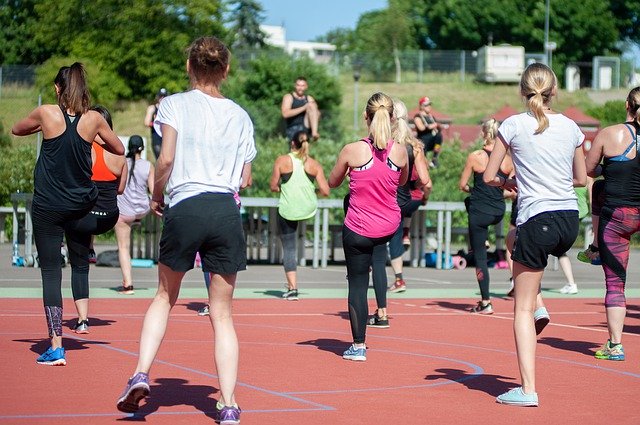We are into the second week of the new year. Many folks have already started on their resolutions for the new year. Exercise is a common resolution for many of you. But the question comes up – how much exercise should I do? Do I go to the gym for an hour three times a week? Should I join that yoga class that runs from 6 to 6:45 am? Maybe I could just hop on the exercise bike that I picked up at that garage sale every morning for 20 minutes or so. What should I do?

My son asked me that question a few days ago and I gave him the best advice I had. The absolute best exercise is the one that you will actually do. People start all kinds of exercise programs this time of year, and they last a month or two at best. Maybe the exercise they chose was boring. Maybe it was simply too hard. Maybe it took too much time. The list of reasons why we give up on our exercise programs is as long as my arm. So the best exercises are the ones you like to do so much that you are motivated to keep doing them all year long. To this point, my son had been doing a lot of bicycle riding. He would ride to work every day in spite of the Seattle weather. But recently his bicycle got stolen from out of his locked office on the fourth floor of a card entry building. He is not sure he wants to invest another $3000 in a bicycle, but he is feeling the need to get back to exercising.
Maybe we should look at the many kinds and purposes of exercise to help us decide. Fundamentally exercise is both a muscle enhancement activity and a nerve enhancement activity. Muscles contain three types of muscle fibers – slow oxidative, fast oxidative, and fast glycolytic. The percentage of each type of fiber is dependent upon the function of the muscle. For instance, postural muscles that have to be able to work continuously all day long are mostly slow oxidative fibers, which have little strength but are able to make lots of the ATP energy molecules so they don’t run out of energy and get tired. On the other end of the spectrum are the power muscles used for sprinting. They are mostly fast glycolytic which does not need oxygen to produce energy. They are able to produce a huge burst of power, but they do not replenish their energy easily and so get tired quickly.
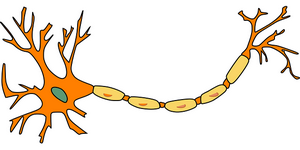
Your nerves come in two primary types to tell muscles what to do and when – motor nerves and proprioceptive nerves. Motor nerves are the big, well-insulated nerves that come from the brain and spinal cord that tell your muscles to contract. Proprioceptive nerves are tiny uninsulated nerves that feel where your body is in space. They communicate how tight muscles and joints are so your brain can get a picture of where your joints are relative to each other so that you can coordinate your movements and produce balance. I like to think of the two types as your movement nerves and your balance nerves. Both types are essential for movement and both types need to be trained to function well. The same is true for your different types of muscle fibers.

The point I am making here is that our exercise needs to contain a variety of types of movement in order to train all the different parts of our neuromuscular system. We need activities that will challenge our strength muscles. We need activities that will challenge our rapid aerobic muscles. We need activities that challenge our balance system and its slow oxidative muscles and proprioceptive nerves. Why do we need these? All of these come into play as we try to live our normal everyday lives. I see these different systems failing in my patients every day. These failures are the biggest reason people need to see me for Chiropractic corrections. And as you would expect, they become more evident and a bigger issue with each passing year.
The saving grace in this otherwise sobering thought is that it does not take very much time to get enough training in to meet our functional needs. And that is what my focus is on meeting our functional needs. If you are desiring to be competitive in an athletic sport, then you will need a lot more work than basic functional needs require. But most of my patients are not competitive athletes, so this discussion is geared for the average person.
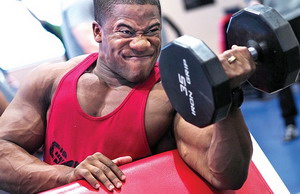
So how much time am I talking about? Let’s start with aerobic fitness. I hear from many patients about how they go to the gym and run on the treadmill for a half-hour to an hour several times a week. What do you actually need? You can achieve aerobic fitness with two and one-half minutes of sprinting twice a week. This is achieved through interval training. This can be done in almost any open area or on a variety of gym equipment. It involves warming up for a couple of minutes then moving as fast as you can for 30 seconds – running, elliptical, stationary bike, rowing machine, stair climbing, treadmill, whatever. After your burst of speed, you cool down for at least a couple minutes and then do it again. Five sets of 30 seconds is a full workout and you don’t repeat it again for at least three days. Those bursts of speed can even be hours apart. In terms of actual time working hard, you only need a total of five minutes a week.
Okay, how about strength training? Again, I am not talking about competition bodybuilding, but maintaining the strength to be able to do what we need to do to live our lives. This really shows up as you get older. Like the aerobic training, heavy strength training is done two times a week with three days of recovery time between training sessions. The simplest approach is with super slow weight training. This can be done either in a gym with weights or at home using bodyweight exercises. With weights, use a weight that is about 70% of your maximum ability to lift. The idea is to slowly contract the weight loaded muscle so that it takes about ten seconds to fully contract the muscle, then slowly return to the beginning position (eccentric contraction) over another ten seconds. Then without pausing begin another slow contraction and return. Keep this movement slow and continuous until you reach the point where the muscle can no longer move because it is exhausted. This should take about 6 to 10 contraction cycles. That is it. Rest and recover for the next few days. If you were counting you would find that it takes about two to three minutes to work out each muscle group. I help Ellen balance and count for her while she does her slow squats to exhaustion every Saturday morning. She also does 10 mini squats every time before she sits down to keep her brain trained.
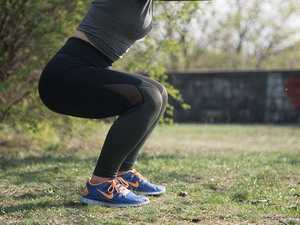
I focus on just a few major muscle groups – the legs with slow squats and slow leg extensions, the chest with slow push-up/away movements, the upper back and arms with slow pulldowns/pull-ins and slow curls, and the lower back with slow row extensions. My total weight workout takes about 20 minutes. The squats and push-ups are easy to do at home as just bodyweight exercises, while the rest are easier with machines or resistance bands. A new super interesting muscle building technique is gaining traction these days. It uses blood flow restriction to the muscles. This is a highly technical technique requiring special equipment, but allows you to get amazing muscle building gains using very small weights.

Okay, so we are talking so far about a time commitment of about a half an hour twice a week. Now we want to add in the daily stuff – stretching and balance. This is where the Yoga, Tai Chi, or Foundation exercises come in. My son showed me his morning Yoga stretching program – it took about five minutes. Obviously having more time to do Yoga is nice, but if you don’t, then five minutes is wonderful. I figure about the same amount of time is necessary for the Foundation program. Simple balance training can be done literally for a few seconds at a time periodically throughout the day. Just close your eyes and try to balance on one foot.
The other essential that qualifies as exercise is simply breaking the sitting habit. The body suffers whenever you sit for more than 20 minutes. Get up – even if only for a few seconds. I like to do a sitting ab and glute contraction every so often to straighten out my back and legs, kind of like a reverse plank in the chair. When you sit too long the psoas muscles that go from your back to your groin shorten up and get stuck that way. You notice it when you do finally get up as they then yank your low back forward and pinch the low back joints.
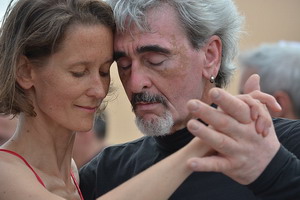
How much is enough? To get the basics for strength and aerobic fitness it does not take much time. Look at the activities you love to do and see if you are able to get the types of movements for fitness from these. Dancing is a wonderful activity that ticks all the right boxes. Martial arts is another great way to get your activity needs met. Gardening can fill those needs. Exercise does not need to look like exercise. We are really talking about the movement of living, and we want to fill our lives with as much living as possible.
Take care,
David
